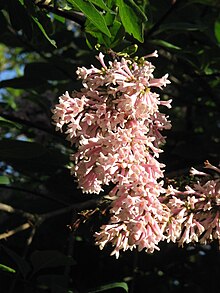Syringa tomentella[1][2] is a species in the genus Syringa, in the family Oleaceae.
| Syringa tomentella | |
|---|---|

| |
| Scientific classification | |
| Kingdom: | Plantae |
| Clade: | Tracheophytes |
| Clade: | Angiosperms |
| Clade: | Eudicots |
| Clade: | Asterids |
| Order: | Lamiales |
| Family: | Oleaceae |
| Genus: | Syringa |
| Species: | S. tomentella
|
| Binomial name | |
| Syringa tomentella | |
Description edit
- Height/spread: Shrub reaching up to 1.5-7m high and wide at maturity.[2]
- Stems: Branchlets are densely to sparsely pubescent.[2]
- Leaves: Petiole measures 0.8-1.5 cm. Pedicel and rachis are pubescent to villous or glabrescent. Leaf blade is elliptic-lanceolate to ovate-lanceolate, or rarely ovate to obovate. Leaf measures approximately 2.5–11 cm in length and 1.5–5 cm in width. The tops of the leaves are glabrous or densely pubescent, with the undersides of the leaves being either completely hairy or hairy along the veins only. Leaf base is sub-rounded to cuneate, while the leaf apex is acuminate to acute.[2]
- Flowers: Panicles are lateral to terminal, erect, and loose, and measure 10–25 cm x 4–12 cm. Pedicel to 1-1.5mm in length. Calyx reaches 2.5-3mm. Corolla measures 1-1.7 cm in length and ranges in colour from white to pink or lilac-red. Tube is slightly funnelform, and measures 0.8-1.4 cm. Lobes are elliptic to ovate and spreading. Anthers are yellow and reach to the mouth or the corolla tube or protrude slightly. Flowers from June–July.[2]
- Fruit: Capsule is oblong-elliptic and is lenticellate or smooth, measuring 1.2–2 cm in length. Fruits appear in September.[2]
Habitat edit
Woodland slopes, valley thickets, and along gullies, 2500-3600m altitude.[2]
Distribution edit
Native to China,[2][3] specifically western Sichuan province,[2] south-central China, and Tibet.[3]
Cultivation edit
Introduced into cultivation in 1904. The Arnold Arboretum received its first specimen in 1907 from the Veitch Nursery in London.[2]
Etymology edit
Tomentella, meaning 'somewhat hairy', a diminutive from tomentum.[2][4] Syringa is derived from the Greek word syrinx, meaning 'pipe' or 'tube'. Named for the use of its hollow stems to make flutes. In Greek mythology, the nymph Syringa was changed into a reed.[4]
References edit
- ^ The Plant List http://www.theplantlist.org/tpl1.1/record/kew-356294
- ^ a b c d e f g h i j k Fiala, John L. "Lilacs: a gardener's encyclopedia", 2nd ed. copyright Timber Press 2008. rev. and updated by Freek Vrugtman. First ed. published 1988, copyright Timber Press. ISBN 9780881927955. pp 112-114
- ^ a b Plants of the World Online. Available at: https://powo.science.kew.org/taxon/urn:lsid:ipni.org:names:611148-1 [accessed 13/02/21]
- ^ a b Gledhill, David (2008). "The Names of Plants". Cambridge University Press. ISBN 9780521866453 (hardback), ISBN 9780521685535 (paperback). pp 369, 381
Further reading edit
- Bureau, Ed.; Franchet, A. (1891). "Plantes nouvelles du Tibet et de la Chine occidentale recueillies pendant le voyage de M. Bonvalot et du Prince Henri d'Orléans en 1890". Journal de Botanique. 5 (7): 103–104.
Syringa tomentella, sp. nov.
- Chang, Mei-chen; Qiu, Lian-qing; Green, Peter S. (1996). "Oleaceae" (PDF). In Wu, Zhengyi; Raven, Peter (eds.). Flora of China. Vol. 15: Myrsinaceae through Loganiaceae. Beijing: Science Press. p. 283. ISBN 9780915279371.
- "Diagnoses specierum novarum in herbario Horti Regii Botanici Edinburgensis cognitarum. (Species chinenses.) CLI–CCL". Notes from the Royal Botanic Garden, Edinburgh. 9 (42): 131–132. 1916.
Syringa Adamiana, Balf. f. et W. W. Sm. Sp. nov.